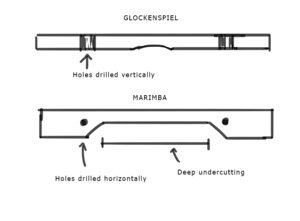Course:PHYS341/Archive/2016wTerm2/glockenspiel
Physics of the Glockenspiel
The glockenspiel, also known as orchestral bells, is a mallet percussion instrument that consists of metal bars arranged like a keyboard which produce definite pitches upon being struck. It is typically played with brass or plastic mallets. [1] The glockenspiel gives off a crisp sound when struck with hard mallets, that gives way to a pure, bell-like tone. It is arranged in a manner similar to a xylophone, but uses metal bars, making it a metallophone. [2]

Bar Construction and Shape
The glockenspiel consists of rectangular steel bars of 2.5-3.2 cm wide and 6-9 mm thick. A portable version, called the Bell Lyra, also uses aluminum bars. [1] The glockenspiel essentially acts as a series of free bars that are allowed to vibrate in many modes. [3] The fundamental frequency or pitch is affected by the material, length and thickness of the bars. The frequency of a uniform bar is directly proportional to its thickness, and thus cutting it in half would lower the pitch by an octave. The frequency also has an inverse square proportion to its length, whereby cutting the length in half would increase the pitch by two octaves. It is through these processes that the bars of the glockenspiel and other instruments can be tuned to different pitches. [4] This is evident in the fact that the glockenspiel’s bars are arranged in a gradually tapering array: the lowest pitches begin at the left, gradually decreasing in length and becoming higher in pitch towards the right.

Nodes
Glockenspiel bars vibrate in different modes. Places in these modes, where no movement actually occurs, are called nodes. Like in other mallet percussion instruments, in the glockenspiel’s second (fundamental) vibrating mode there are two nodes.It is at these nodes that the bars must be supported in order to allow it to be struck and to vibrate. [4] Each of the glockenspiel’s bars has holes drilled at these nodes, which allows the bar to be physically supported by a screw and placed on a wooden or metal frame. Besides physically supporting the bars, suspending them at these nodes also dampens the other vibrational modes, giving it a defined frequency. [5]
Overtones
When a mallet percussion instrument such as the glockenspiel is struck, it vibrates at a fundamental frequency while emitting a series of overtones. These overtones are generally not harmonic (i.e. not integer multiples of the fundamental), which affects the timbre of the sound. [3] However, in instruments like the marimba or xylophone, the first overtone of the bar is made more harmonic by undercutting, or removing material from under the middle of the bar, in order to lower the fundamental frequency while keeping the first overtone the same. This results in a broader range between the fundamental and first overtone, bringing the two into a more harmonic ratio. [4]
The glockenspiel similarly has no harmonic overtones. However, the overtones it produces are very high in frequency and die out quickly, thus having less of an effect on its timbre compared with the marimba or xylophone. Because the glockenspiel has a fairly high range in pitch, its overtones occur at a range where pitch discrimination is less of a concern for human hearing. As a result, the glockenspiel is not generally tuned or made more harmonic by undercutting the bars, and thus its bars are mostly uniform throughout. [1]
The rate of decay for the fundamental and other modes is not the same for the glockenspiel, which is what defines its initial harsh sound followed by its bell-like tone. The initial strike produces large numbers of inharmonic overtones, but these quickly fade, leaving a purer tone that vibrates for much longer. [5]
See Also
References
- ↑ 1.0 1.1 1.2 Fletcher, Neville H. The Physics of Musical Instruments. Springer 1998.
- ↑ "The Vibraphone and Glockenspiel." All About Mallet Percussion, https://web.archive.org/web/20100706232650/http://www.mallet-percussion.com/vibes.html.
- ↑ 3.0 3.1 Rossing, Thomas D. "Acoustics of mallet percussion instruments." The Journal of the Acoustical Society of America, http://asa.scitation.org/doi/abs/10.1121/1.2015478.
- ↑ 4.0 4.1 4.2 Flynt, W.E. "The Construction and Tuning of Vibrating Bars." Mechanical Music Digest, https://www.mmdigest.com/Gallery/Tech/XyloBars.html.
- ↑ 5.0 5.1 Forinash, K. " SOUND - An Interactive eBook on the Physics of Sound." Indiana University Southeast, https://soundphysics.ius.edu/?page_id=1163.